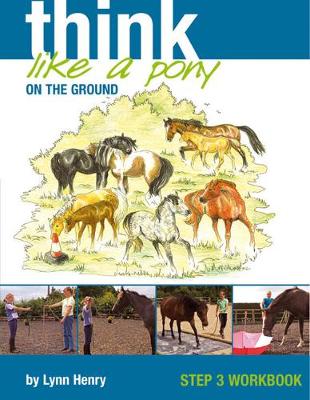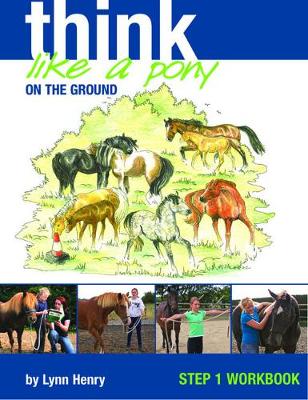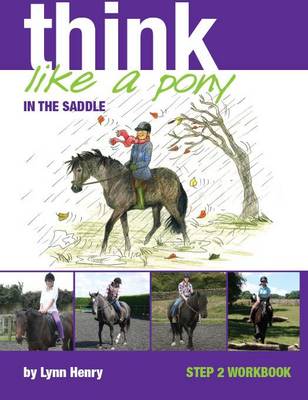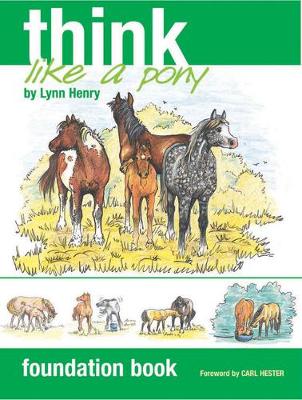Think Like a Pony
5 total works
All pony-mad children (and their parents) want a pony who has perfect manners, is confident, happy and, above all, safe. This series of education workbooks, based on understanding pony behaviour, shows how you can create the pony of your dreams.
By working through simple, fun exercises, with and without a pony, you (and your parents) will discover what makes ponies 'tick'. This series of books shows how you can use that knowledge to develop a wonderful relationship with your pony, based on leadership, trust and communication.
These first three books (step1, step 2, and step 3) cover training on the ground. They contain imaginative exercises to train both ponies and handlers, using signals that ponies can readily understand. The exercises are designed to improve all aspects of handling and are an essential preparation for riding.
Chapters include:
By working through simple, fun exercises, with and without a pony, you (and your parents) will discover what makes ponies 'tick'. This series of books shows how you can use that knowledge to develop a wonderful relationship with your pony, based on leadership, trust and communication.
These first three books (step1, step 2, and step 3) cover training on the ground. They contain imaginative exercises to train both ponies and handlers, using signals that ponies can readily understand. The exercises are designed to improve all aspects of handling and are an essential preparation for riding.
Chapters include:
- Follow your nose
- Move on a circle
- Turning with your pony on a circle
- Asking your pony to keep his nose on a circle
- Transitions on a circle
- Moving sideways
- Leading your pony from his shoulder
- Narrow spaces
- Obstacles and more
All pony-mad children (and their parents) want a pony who has perfect manners, is confident, happy and, above all, safe. This series of eductions workbooks, based on understanding pony behaviour, shows how you can create the pony of your dreams.
By working through simple, fun exercises, with and without a pony, you (and your parents) will discover what makes ponies 'tick'. This series of books shows how you can use that knowledge to develop a wonderful relationship with your pony, based on leadership, trust and communication.
These first three books (step1, step 2, and step 3) cover training on the ground. They contain imaginative exercises to train both ponies and handlers, using signals that ponies can readily understand. The exercises are designed to improve all aspects of handling and are an essential preparation for riding.
Chapters include:
By working through simple, fun exercises, with and without a pony, you (and your parents) will discover what makes ponies 'tick'. This series of books shows how you can use that knowledge to develop a wonderful relationship with your pony, based on leadership, trust and communication.
These first three books (step1, step 2, and step 3) cover training on the ground. They contain imaginative exercises to train both ponies and handlers, using signals that ponies can readily understand. The exercises are designed to improve all aspects of handling and are an essential preparation for riding.
Chapters include:
- Your pony's feet
- Developing feel
- Your equipment and using it
- Protecting your personal space
- Catching your pony
- Putting on the halter
All pony-mad children (and their parents) want a pony who has perfect manners, is confident, happy and, above all, safe. This series of education workbooks, based on understanding pony behaviour, shows how you can create the pony of your dreams.
By working through simple, fun exercises, with and without a pony, you (and your parents) will discover what makes ponies 'tick'. This series of books shows how you can use that knowledge to develop a wonderful relationship with your pony, based on leadership, trust and communication.
These first three books (step1, step 2, and step 3) cover training on the ground. They contain imaginative exercises to train both ponies and handlers, using signals that ponies can readily understand. The exercises are designed to improve all aspects of handling and are an essential preparation for riding.
Chapters include:
By working through simple, fun exercises, with and without a pony, you (and your parents) will discover what makes ponies 'tick'. This series of books shows how you can use that knowledge to develop a wonderful relationship with your pony, based on leadership, trust and communication.
These first three books (step1, step 2, and step 3) cover training on the ground. They contain imaginative exercises to train both ponies and handlers, using signals that ponies can readily understand. The exercises are designed to improve all aspects of handling and are an essential preparation for riding.
Chapters include:
- Becoming a leader
- Please follow me and respect my personal space
- Asking your pony to move his front end and his hindquarters
- Using signals of rhythmic pressure to ask your pony to move his front end and his hindquarters
- Asking your pony to pick up his feet
Some parents have young children who are 'pony mad', but they themselves have no understanding or knowledge of ponies. By reading this book with their children, they can learn together and enjoy the fascinating journey of understanding pony behaviour.
Armed with this knowledge and understanding readers can appreciate how a pony can become:
No matter how long a parent or child has been involved with ponies, there are always new things to learn and understand. There may be 'that pony' who makes you think that you know nothing at all!
Whether a child reads this book alone or with an adult, it is the beginning of a wonderful journey for both child and pony.
Foreword by Carl Hester.
Armed with this knowledge and understanding readers can appreciate how a pony can become:
- safe to be with
- safe to handle
- safe to ride
- a willing friend and partner.
No matter how long a parent or child has been involved with ponies, there are always new things to learn and understand. There may be 'that pony' who makes you think that you know nothing at all!
Whether a child reads this book alone or with an adult, it is the beginning of a wonderful journey for both child and pony.
Foreword by Carl Hester.




